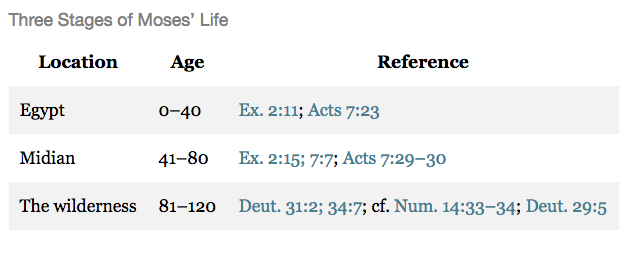When I first started working on the ESV Study Bible, ten years ago, one of the most enjoyable projects was trying my hand at some charts that would summarize the ages and timelines of various figures. If you are reading through the Bible on your own, this information can be difficult to track as it is not presented systematically. For example, we learn in Exodus 7:7 that Moses is 80 years old when he returns to Egypt to confront Pharaoh. (We also learn in that verse that Aaron is three years older than his brother Moses.) And at the end of the Pentateuch we learn that Moses is 120 years old when he dies (Deut. 34:7). But it’s not until Acts 7:23 that we learn that Moses was 40 years old when he fled Egypt for the first time.
So when we put all the data together, a simple chart emerges:

Lately I’ve tried to do something similar with the Patriarchs and some of their key descendants prior to the time of Moses. It’s interesting to me not only for seeing the age in which someone died (say, Abraham at the age of 175), but how old his sons and grandsons where when he died (Isaac was 75 and Jacob was 15). The Bible does not explicitly say those latter ages, but they can be deduced mathematically (e.g., Abraham was 100 when Isaac was born, so if Abraham died at 175 then Isaac would have been 75). Does any of this matter much when we read through the Old Testament narratives? Probably not. But it helps me, at least, to remember that these are real people (not just stories) and to picture them at various stages of their lives. It also reminds me of the compressed nature of these narratives, as the story can often times skip decades ahead from one verse to the next.
In the chart below, I added something in the far-right column that might only make sense to someone who has a weird brain like mine. I noticed that the time period from Abraham to Joseph was 361 years (2166-1805). That’s a good chunk of time. What if we were to make each year roughly equivalent to a calendar day in a single year. So if Abraham was born in year 1, that would be January 1.
In other words, if the Patriarchal period was compressed to the timeline of a year, then Abraham would be born on January 1, Isaac would be born on April 9, Jacob would be born on June 8, and Joseph would be born on September 18. Abraham would die on June 23, Isaac would die on October 6, Jacob would die on November 19, and Joseph would die on December 26.
If that part makes sense only to me, so be it. You can ignore that column on the chart.
Here it is:
[table id=3 /]
For the dates, I’ve used the ESV Study Bible and Andrew Steinmann’s indispensable resource for biblical chronology, From Abraham to Paul: A Biblical Chronology (Concordia, 2011).


















